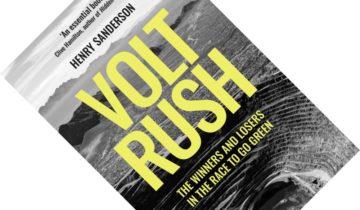Sarah Scoles in Undark:
 SOMETIME THIS COMING March, a network of 10 small satellites winged with solar panels is scheduled to launch into Earth’s low orbit. Though likely invisible to the naked eye, the satellites will be part of a future herd of hundreds that, according to the Space Development Agency, or SDA, will bolster the United States’ defense capabilities.
SOMETIME THIS COMING March, a network of 10 small satellites winged with solar panels is scheduled to launch into Earth’s low orbit. Though likely invisible to the naked eye, the satellites will be part of a future herd of hundreds that, according to the Space Development Agency, or SDA, will bolster the United States’ defense capabilities.
The SDA, formed in 2019, is an organization under the United States Space Force, the newly formed military branch that operates and protects American assets in space. And like all good startups, the agency is positioned as a disruptor. It aims to change the way the military acquires and runs its space infrastructure. For instance, the forthcoming satellite network, called the National Defense Space Architecture, will collectively gather and beam information, track missiles, and help aim weapons, among other tasks.
The SDA’s vision both mimics and relies on shifts that started years ago in the commercial sector: groupings of cheap little satellites — often weighing hundreds of pounds, instead of thousands — that together accomplish what fewer big, expensive satellites used to.
More here.

 One name you don’t hear a lot these days is Thomas Piketty. In 2013, the French economist burst into the popular consciousness with the publication of
One name you don’t hear a lot these days is Thomas Piketty. In 2013, the French economist burst into the popular consciousness with the publication of 
 The invisibility of the disaster presents a serious difficulty to the filmmakers, who need their viewers to perceive it as the expert does. Their ingenious solution is found in the technical disaster movie’s pronounced ambience: the bustled score and sweaty palettes of Contagion; Chernobyl’s ghostly clanks and drones; the blare of Bloomberg terminals and pristine skylines of Margin Call. Through these effects, viewers are invited to pretend we know things we manifestly do not. We work through the night with Sullivan as he discovers his financial firm’s impending demise, study his stubbled face as he looks up from his illegible scrawl of equations before a pulsing monotone—and we simply know he’s uncovered something. The camera of Contagion fixates upon “fomites” (common objects that facilitate disease transmission), such that we learn to almost see viruses slithering over bus handles, glassware and casino chips. Chernobyl represents the presence of radiation with the throaty static of dosimeters (audible radiological instruments) that is often so loud and unnerving we forget we don’t exactly know what the sound means. Technical knowledge becomes an artificial sensorium, a collage of abstractions forced onto the nerve endings, always attempting to compensate for its baselessness.
The invisibility of the disaster presents a serious difficulty to the filmmakers, who need their viewers to perceive it as the expert does. Their ingenious solution is found in the technical disaster movie’s pronounced ambience: the bustled score and sweaty palettes of Contagion; Chernobyl’s ghostly clanks and drones; the blare of Bloomberg terminals and pristine skylines of Margin Call. Through these effects, viewers are invited to pretend we know things we manifestly do not. We work through the night with Sullivan as he discovers his financial firm’s impending demise, study his stubbled face as he looks up from his illegible scrawl of equations before a pulsing monotone—and we simply know he’s uncovered something. The camera of Contagion fixates upon “fomites” (common objects that facilitate disease transmission), such that we learn to almost see viruses slithering over bus handles, glassware and casino chips. Chernobyl represents the presence of radiation with the throaty static of dosimeters (audible radiological instruments) that is often so loud and unnerving we forget we don’t exactly know what the sound means. Technical knowledge becomes an artificial sensorium, a collage of abstractions forced onto the nerve endings, always attempting to compensate for its baselessness. Awe can mean many things. It can be witnessing a total solar eclipse. Or seeing your child take her first steps. Or hearing Lizzo perform live. But, while many of us know it when we feel it, awe is not easy to define. “Awe is the feeling of being in the presence of something vast that transcends your understanding of the world,” said Dacher Keltner, a psychologist at the University of California, Berkeley.
Awe can mean many things. It can be witnessing a total solar eclipse. Or seeing your child take her first steps. Or hearing Lizzo perform live. But, while many of us know it when we feel it, awe is not easy to define. “Awe is the feeling of being in the presence of something vast that transcends your understanding of the world,” said Dacher Keltner, a psychologist at the University of California, Berkeley. To learn to socialize, zebrafish need to trust their gut. Gut microbes encourage specialized cells to prune back extra connections in brain circuits that control social behavior, new University of Oregon research in zebrafish shows. The pruning is essential for the development of normal social behavior.
To learn to socialize, zebrafish need to trust their gut. Gut microbes encourage specialized cells to prune back extra connections in brain circuits that control social behavior, new University of Oregon research in zebrafish shows. The pruning is essential for the development of normal social behavior. Each of us constructs and lives a “narrative”,’ wrote the British neurologist Oliver Sacks, ‘this narrative is us’. Likewise the American cognitive psychologist Jerome Bruner: ‘Self is a perpetually rewritten story.’ And: ‘In the end, we become the autobiographical narratives by which we “tell about” our lives.’ Or a fellow American psychologist, Dan P McAdams: ‘We are all storytellers, and we are the stories we tell.’ And here’s the American moral philosopher J David Velleman: ‘We invent ourselves… but we really are the characters we invent.’ And, for good measure, another American philosopher, Daniel Dennett: ‘we are all virtuoso novelists, who find ourselves engaged in all sorts of behaviour… and we always put the best “faces” on it we can. We try to make all of our material cohere into a single good story. And that story is our autobiography. The chief fictional character at the centre of that autobiography is one’s self.’
Each of us constructs and lives a “narrative”,’ wrote the British neurologist Oliver Sacks, ‘this narrative is us’. Likewise the American cognitive psychologist Jerome Bruner: ‘Self is a perpetually rewritten story.’ And: ‘In the end, we become the autobiographical narratives by which we “tell about” our lives.’ Or a fellow American psychologist, Dan P McAdams: ‘We are all storytellers, and we are the stories we tell.’ And here’s the American moral philosopher J David Velleman: ‘We invent ourselves… but we really are the characters we invent.’ And, for good measure, another American philosopher, Daniel Dennett: ‘we are all virtuoso novelists, who find ourselves engaged in all sorts of behaviour… and we always put the best “faces” on it we can. We try to make all of our material cohere into a single good story. And that story is our autobiography. The chief fictional character at the centre of that autobiography is one’s self.’ What do Noam Chomsky, living legend of linguistics, Kai-Fu Lee, perhaps the most famous AI researcher in all of China, and Yejin Choi, the 2022 MacArthur Fellowship winner who was profiled earlier this week in The New York Times Magazine—and more than a dozen other scientists, economists, researchers, and elected officials—all have in common?
What do Noam Chomsky, living legend of linguistics, Kai-Fu Lee, perhaps the most famous AI researcher in all of China, and Yejin Choi, the 2022 MacArthur Fellowship winner who was profiled earlier this week in The New York Times Magazine—and more than a dozen other scientists, economists, researchers, and elected officials—all have in common? The problems created by humanity’s dependence on fossil fuels are widely appreciated, and governments and businesses are now pursuing renewable energy and electric vehicles as the solution. Less appreciated is that this new infrastructure will require the mining of vast amounts of metals, creating different problems. In Volt Rush, Financial Times journalist Henry Sanderson gives a well-rounded and thought-provoking exposé of the companies and characters behind the supply chain of foremost the batteries that will power the vehicles of the future. If you think a greener and cleaner world awaits us, Volt Rush makes it clear that this is far from a given.
The problems created by humanity’s dependence on fossil fuels are widely appreciated, and governments and businesses are now pursuing renewable energy and electric vehicles as the solution. Less appreciated is that this new infrastructure will require the mining of vast amounts of metals, creating different problems. In Volt Rush, Financial Times journalist Henry Sanderson gives a well-rounded and thought-provoking exposé of the companies and characters behind the supply chain of foremost the batteries that will power the vehicles of the future. If you think a greener and cleaner world awaits us, Volt Rush makes it clear that this is far from a given. I really enjoy doing it: it makes me feel good about myself. It gives me a boost, mentally and physically.” If these were your reactions to an activity, you’d surely be inclined to do it as often as you could. After all, aren’t a lot of us looking for ways to find more meaning in life and to be happier and healthier? What, then, is the act that elicits such positive responses? The answer: being
I really enjoy doing it: it makes me feel good about myself. It gives me a boost, mentally and physically.” If these were your reactions to an activity, you’d surely be inclined to do it as often as you could. After all, aren’t a lot of us looking for ways to find more meaning in life and to be happier and healthier? What, then, is the act that elicits such positive responses? The answer: being  S
S In recent years, the vagus nerve has become an object of fascination, especially on social media. The vagal nerve fibers, which run from the brain to the abdomen, have been anointed by some influencers as the key to reducing anxiety, regulating the nervous system and helping the body to relax.
In recent years, the vagus nerve has become an object of fascination, especially on social media. The vagal nerve fibers, which run from the brain to the abdomen, have been anointed by some influencers as the key to reducing anxiety, regulating the nervous system and helping the body to relax. Alex Turnbull in Phenomenal World:
Alex Turnbull in Phenomenal World: